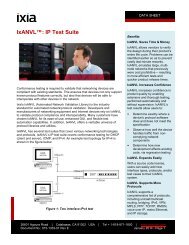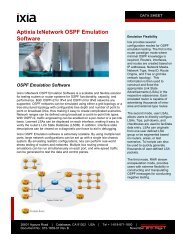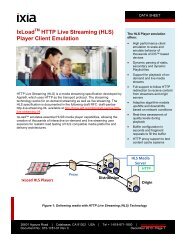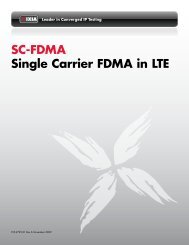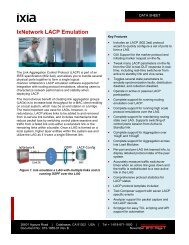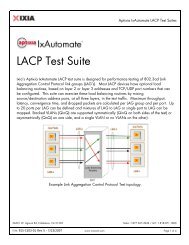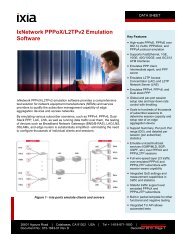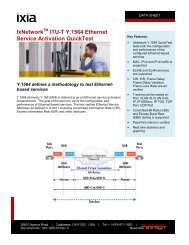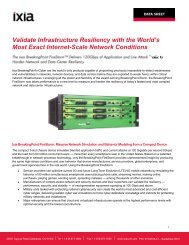Multi-Protocol Label Switching (MPLS) Conformance and ... - Ixia
Multi-Protocol Label Switching (MPLS) Conformance and ... - Ixia
Multi-Protocol Label Switching (MPLS) Conformance and ... - Ixia
You also want an ePaper? Increase the reach of your titles
YUMPU automatically turns print PDFs into web optimized ePapers that Google loves.
<strong>MPLS</strong> VPNs vs. IPSec VPNs. The term VPN can be confusing, as it is used to describe anumber of technologies. VPNs can be organized into two broad categories:• Customer-based: the VPN is configured exclusively on customer- located equipment<strong>and</strong> uses tunneling protocols across the public network, most commonly IPSec.• Network-based: the VPN is configured on service provider equipment <strong>and</strong> managed bythe provider. <strong>MPLS</strong> VPNs are an example of network-based VPNs.IPSec adds secure encryption capabilities to IP. It is typically managed by the endcustomer, outside of a service provider’s network, where there is a higher degree ofexposure to breaches of data privacy.IPSec is especially useful for securing remote location VPN connections back to thecorporate network.<strong>MPLS</strong> VPNs aremaintained on theservice provider’sequipment, whichcan providesignificant costsavings <strong>and</strong>increased scalabilitycompared with otherVPN technologies.<strong>MPLS</strong> VPNs are maintained on the service provider’s equipment, which can providesignificant cost savings <strong>and</strong> increased scalability compared with other VPN technologies.<strong>MPLS</strong> VPNs keep different customers’ traffic separated by uniquely identifying each VPNflow <strong>and</strong> setting up circuit-like connections. This mechanism provides traffic separation<strong>and</strong> is transparent to end users within the VPN group. <strong>MPLS</strong> VPNs provide securityinherently, essentially making IP as secure as Frame Relay or ATM, <strong>and</strong> reducing the needfor encryption. Miercom, an independent network consultancy <strong>and</strong> testing laboratory,tested <strong>MPLS</strong> VPN security on a network of various routers, <strong>and</strong> concluded (2001): “Ourtest results have demonstrated that <strong>MPLS</strong>-based VPN networks offer the same level ofsecurity as Frame Relay or ATM.”L3 VPNs. <strong>MPLS</strong> VPNs fall into two broad classes — those that operate at Layer 3 <strong>and</strong>those that operate at Layer 2. Layer 3 VPNs were first to be investigated <strong>and</strong> st<strong>and</strong>ardizedin RFCs. Layer 3 VPNs based on RFC 2547bis have seen the most widespread deploymentto date.RFC 2547bis-based Layer 3 VPNs use extensions to BGP, specifically <strong>Multi</strong>- <strong>Protocol</strong>internal BGP (MP-iBGP), to distribute VPN routing information across the providerbackbone. St<strong>and</strong>ard <strong>MPLS</strong> mechanisms (as previously discussed) are used to forward theVPN traffic across the backbone. In an L3 VPN, the CE <strong>and</strong> PE routers are IP routing peers.The CE router provides the PE router with the routing information for the customer’sprivate network behind it. The PE router stores this private routing information in a VirtualRouting <strong>and</strong> Forwarding (VRF) table; each VRF is essentially a private IP network. ThePE router maintains a separate VRF table for each VPN, thereby providing appropriateisolation <strong>and</strong> security. VPN users have access only to sites or hosts within the same VPN.In addition to the VRF tables, the PE router also stores the normal routing information itneeds to send traffic over the public Internet.10



